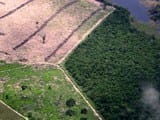



To read this article, click here.
Logging in natural forests is a vital economic activity in the Brazilian Amazon. However, illegal and unplanned logging is exhausting forests rapidly. In 2006, a new forestry law in Brazil (Lei 11,284/2006) established the legal framework to develop state and national public forests for multiple uses. To support public forest planning efforts, we combine spatially explicit data on logging profits, biodiversity, and potential for community use for use within a forest planning optimization model. While generating optimal land use configurations, the model enables an assessment of the market and nonmarket tradeoffs associated with different land use priorities. We demonstrate the model’s use for Faro State Forest, a 636,000 ha forest embedded within a large mosaic of conservation units recently established in the state of Pará. The datasets used span the entire Brazilian Amazon, implying that the analysis can be repeated for any public forest planning effort within the region.
This post was published on 27 de May de 2011
Several authors. System for Monitoring Timber Harvesting (Simex): Mapping of logging in the Brazilian Amazon…
Souza Jr, Carlos M; Marengo, José; Ferreira, Bruno; Ribeiro, Júlia; Schirmbeck, Lucimara W; Schirmbeck, Juliano;…
Several authors. System for Monitoring Timber Harvesting (Simex): Mapping logging in Amazonas State – August…
Several authors. System for Monitoring Timber Harvesting (Simex): Mapping logging in Roraima State – August…
Several authors. System for Monitoring Timber Harvesting (Simex): Mapping logging in Amapá State – August…
Several authors. System for Monitoring Timber Harvesting (Simex): Mapping logging in Pará State - August…